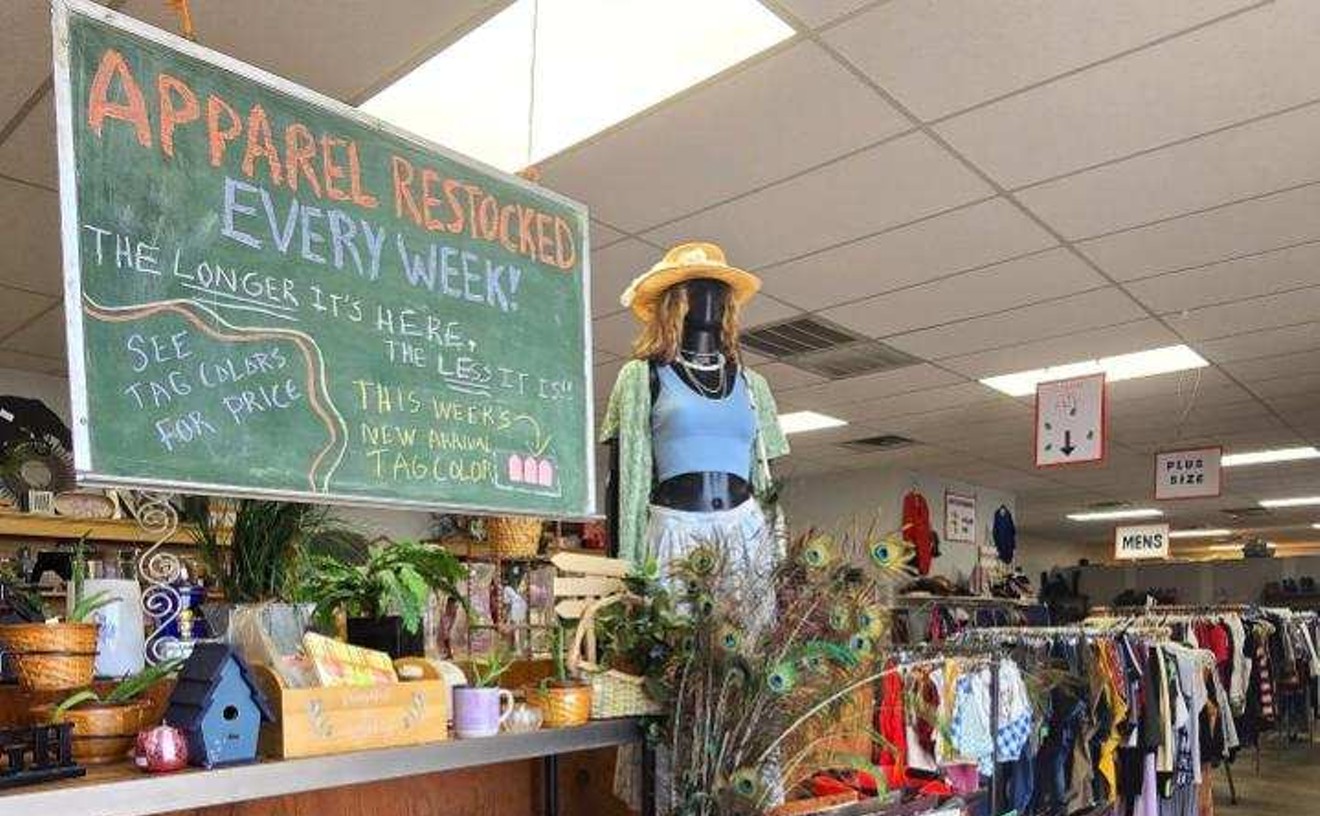Like much contemporary art, the work of Lucie Stahl grows more fascinating the longer you spend with it.
On first encounter, Stahl’s work doesn’t resemble the kind of art one expects to find in a serious museum like the Dallas Museum of Art, where it is on view through March 12. The extreme polish of her oversized posters, an effect the artist achieves by coating her screen prints in epoxy resin, can come across as kitschy, especially when paired with the recognizable branded objects she uses as found material in her staged photographs.
Stahl is the 60th artist to be featured in the DMA's Concentrations series, which showcases project-based works by contemporary, often emerging artists. The show is the Berlin-based artist’s first solo museum show in the U.S.
Stahl uses a flatbed scanner to create staged images in which she combines an odd variety of found objects, surreal characters and newspaper clippings. In an interview with DMA curator Gabriel Ritter which accompanies the exhibition, Stahl comments on her fascination with “finish fetish,” a trend in art perhaps most notable in the work of the Southern California Light and Space artists of the 1960s and '70s.
Artists such as Larry Bell and James Turrell interpreted the move toward minimalism in their very own highly polished way, and the glossy sheen of Stahl’s work certainly recalls their aggressive rejection of the industrial materials that preceded them in the realms of minimalist and conceptual art.
Indeed Stahl’s work is a very 21st century reaction to the industrial polish of minimalism, as well as the assemblage art of artists such as Joseph Cornell and Robert Rauschenberg.
But where much of the earlier work Stahl references intentionally rejected any sign of the human hand, many of her pieces include a human hand or hands as central players. When visitors enter the DMA’s installation, one of the first pieces they encounter is a dizzyingly colorful, almost grotesque image of two hands grasping a coke can, smashed pomegranates and their juices covering what appears to be the screen.
In another image in the main room, two hands, covered in clay or mud, seem to catch two tiny packages of toilet paper before they float away. In yet another, which Stahl calls "Companionship," a grimy hand grasps a ship in a bottle.
In fact, even when there isn’t a hand visible in the work, the clearly staged nature of Stahl’s images suggest the presence of an invisible hand. These pieces never seem haphazardly assembled, although occasionally their subjects — one image of discarded beer cans, another of disposable convenience store cups — feature cold examples of consumer culture.
Stahl is obviously fascinated with how we perceive, both visually and mentally, advertising, animation and consumer products — all ubiquitous in modern culture. She wants, like so many contemporary artists, to make her viewer uncomfortable, to lean into the banal reality we would often like to deny we are complicit in, to force us to consider how we go about our lives.
The objects she depicts may have been found by chance, or chosen at random, but the resin she coats them in serves a purpose, acting as prison bars that trap them while also preserving an aura of mystery.
Stahl’s visual reality is the dark underbelly of that immaculate, shiny future of early science fiction. It's a time we're nostalgic for, when advertising and brands were beacons of a limitless future, before we realized that, as Stahl puts it, consumer culture flattens reality by conflating desire with need.
Stahl includes Coke cans and convenient packages of toilet paper in her images and represents them as our trash, symbols of our commodity fetish and the missing innocence of childhood. The consumer objects appear to fight to escape the photographic prison.
There’s one piece in the show in which Stahl juxtaposes bamboo stalks with a knife-wrapped copy of the New York Times. There's a legible column by Maureen Dowd equating voter’s faith in their ability to make a difference to our belief in time travel; each are equally far-fetched in 2016.
What happens, Stahl seems to be asking, when plants and politics, or advertising and religious imagery, are conflated? She questions our foundation, the language we use, the things we consume and our pre-wired associations, pointing out that everything is political, especially in the art world. Where did those associations come from? Are we uncomfortable with the fact that we don’t know and that we can’t escape them?
See Concentrations: Lucie Stahl at the Dallas Museum of Art (1717 N. Harwood St.) through March 12, 2017. Admission is free. For more info, visit dma.org.

Audio By Carbonatix
[
{
"name": "Air - MediumRectangle - Inline Content - Mobile Display Size",
"component": "18855504",
"insertPoint": "2",
"requiredCountToDisplay": "2",
"watchElement": ".fdn-content-body",
"astAdList": [
{
"adType": "rectangle",
"displayTargets": "mobile"
}
]
},{
"name": "Editor Picks",
"component": "17105533",
"insertPoint": "4",
"requiredCountToDisplay": "1",
"watchElement": ".fdn-content-body",
"astAdList": [
{
"adType": "rectangle",
"displayTargets": "desktop|tablet"
},{
"adType": "rectangle",
"displayTargets": "desktop|tablet|mobile"
}
]
},{
"name": "Inline Links",
"component": "18349797",
"insertPoint": "8th",
"startingPoint": 8,
"requiredCountToDisplay": "7",
"maxInsertions": 25
},{
"name": "Air - MediumRectangle - Combo - Inline Content",
"component": "17105532",
"insertPoint": "8th",
"startingPoint": 8,
"requiredCountToDisplay": "7",
"maxInsertions": 25,
"watchElement": ".fdn-content-body",
"astAdList": [
{
"adType": "rectangle",
"displayTargets": "desktop|tablet"
},{
"adType": "rectangle",
"displayTargets": "desktop|tablet|mobile"
}
]
},{
"name": "Inline Links",
"component": "18349797",
"insertPoint": "8th",
"startingPoint": 12,
"requiredCountToDisplay": "11",
"maxInsertions": 25
},{
"name": "Air - Leaderboard Tower - Combo - Inline Content",
"component": "17105535",
"insertPoint": "8th",
"startingPoint": 12,
"requiredCountToDisplay": "11",
"maxInsertions": 25,
"watchElement": ".fdn-content-body",
"astAdList": [
{
"adType": "leaderboardInlineContent",
"displayTargets": "desktop|tablet"
},{
"adType": "tower",
"displayTargets": "mobile"
}
]
}
]










